It is well known that circular Keplerian protoplanetary discs are expected to produce symmetric double-peaked molecular line profiles (Horne & Marsh 1986). Contrary to this simple symmetric disc assumption, asymmetric CO line profiles in the fundamental band have been observed in several cases. Grid-based numerical simulations of Kley & Dirksen (2006) have shown that local disc eccentricity might form in planet bearing disc near the gap. The theory of resonant excitation mechanisms in accretion discs of Lubow (1991) predicts that the circumstellar discs of close-separation young binaries might become fully eccentric due to the orbiting companion. Horne (1995) has shown that supersonic turbulence might cause observable line profile distortions. As the orbital velocity of gas parcels is highly supersonic in accretion discs, the disc eccentricity results in supersonic velocity distortions. Therefore distorted molecular line profiles are expected to form in giant planet bearing locally eccentric protoplanetary discs (Regaly et al. 2010) and fully eccentric circumstellar discs of close-separation young binaries (Regaly et al. 2011). Recently, it is revealed that the whole disc become eccentric inside the planetary orbit, where the CO is thermally excited, which results in clearly asymmetric CO line profiles (Regaly et al. 2014).
Detectability of giant planets in protoplanetary discs by CO emission lines
|
Planets are thought to form in protoplanetary accretion discs around young stars. Detecting a giant planet still embedded in a protoplanetary disc would be very important and give observational constraints on the planet-formation process. However, detecting these planets with the radial velocity technique is problematic owing to the strong stellar activity of these young objects. |
|
|
We intend to provide an indirect method to detect Jovian planets by studying near infrared emission spectra originating in the protoplanetary discs around T Tauri stars. Our idea is to investigate whether a massive planet could induce any observable effect on the spectral lines emerging in the discs atmosphere. As a tracer molecule we propose CO, which is excited in the ro-vibrational fundamental band in the disc atmosphere to a distance of ~2-3AU (depending on the stellar mass) where terrestrial planets are thought to form. |
|
|
We developed a semi-analytical model to calculate synthetic molecular spectral line profiles in a protoplanetary disc using a double layer disc model heated on the outside by irradiation by the central star and in the midplane by viscous dissipation due to accretion. 2D gas dynamics were incorporated in the calculation of synthetic spectral lines. The motions of gas parcels were calculated by the publicly available hydrodynamical code FARGO which was developed to study planet-disc interactions. |
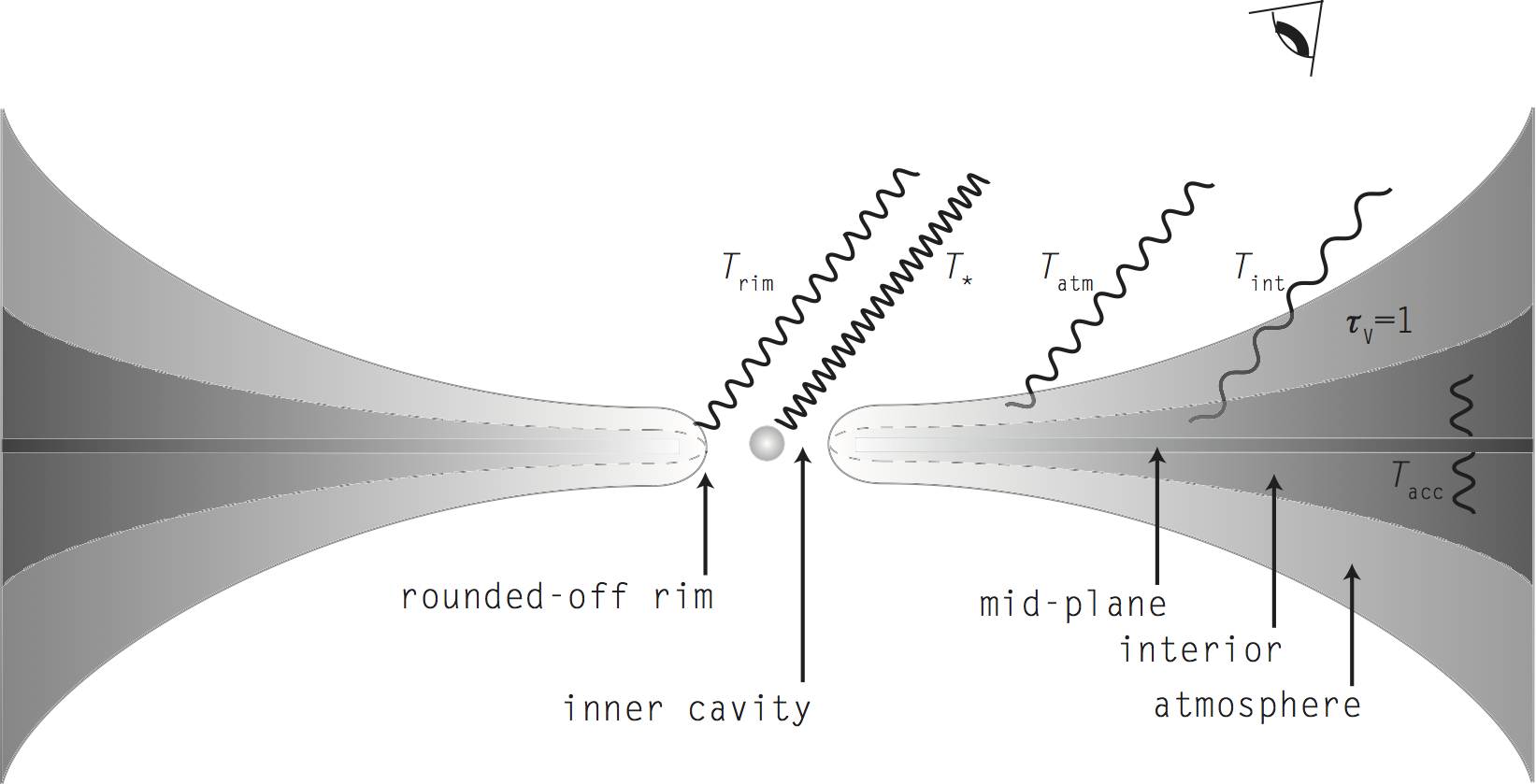 Thermal model of the disc. 
Thermal model of the disc. |
|
We demonstrate that a massive planet embedded in a protoplanetary disc strongly influences the originally circular Keplerian gas dynamics. Similarly to Kley & Dirksen (2006) We also found that in a disc with an embedded massive planet the overall orbits of gas parcels are non-circularly Keplerian because the radial components of their orbital velocity distribution are strongly departing from zero. Moreover, we found that the elliptic gap, while preserving its shape, precesses slowly retrograde with a period of about 150 planetary orbits. Since the gas velocity in an eccentric orbit departs from the circular Keplerian angular velocity with comparable speed as the local sound speed, the perturbed motion of the gas can be detected by comparing the CO line profiles in emission, which emerge from planet-bearing to those of planet-free disc models. |
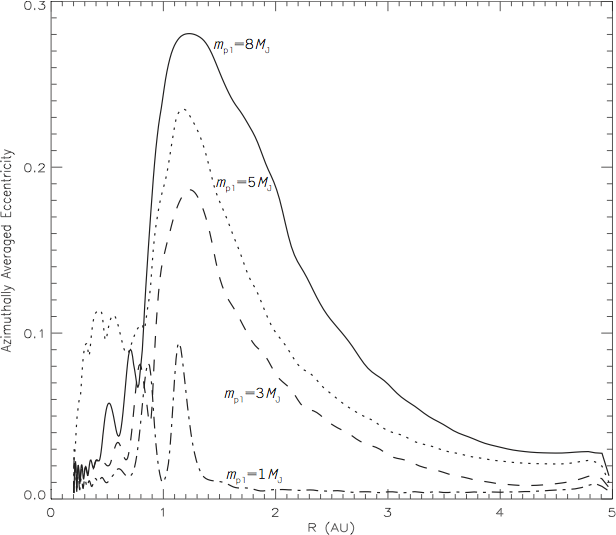 Disc eccentricity induced by giant planet. 
Disc eccentricity induced by giant planet. |
|
Perturbed disc's density, radial velocity and the variation of P10 CO ro-vib lines (20,40 and 60 deg. inclinations) during an orbit of giant planet. |
|
|
The planet signal has two major characteristics: a permanent line profile asymmetry, and short timescale variability correlated with the orbital phase of the giant planet. We have found that the strength of the asymmetry depends on the physical parameters of the star-planet-disc system, such as the disc inclination angle, the planetary and stellar masses, the orbital distance, and the size of the disc inner cavity. The permanent line profile asymmetry is caused by a disc in an eccentric state in the gap opened by the giant planet. However, the variable component is a consequence of the local dynamical perturbation by the orbiting giant planet. We show that a forming giant planet, still embedded in the protoplanetary disc, can be detected using contemporary or future high-resolution near-IR spectrographs like VLT/CRIRES and ELT/METIS. |
|
Appeared in Regály, Zs.; Sándor, Zs.; Dullemond, C. P.; van Boekel, R., 2010, A&A, Volume 523, id.A69
ADS:2010A&A…523A..69R,
arXiv:1007.2169
Spectral signatures of disc eccentricity in binaries
|
Star formation occurs via fragmentation of molecular clouds, which means that the majority of stars born are members of binary systems. There is growing evidence that planets might form in circumprimary discs of medium-separation (<50AU) binaries. The tidal forces caused by the secondary generally act to distort the originally circular circumprimary disc to an eccentric one. Since the disc eccentricity might play a major role in planet formation, it is of great importance to understand how it evolves. We investigate disc eccentricity evolution to reveal its dependence on the physical parameters of the binary system and the protoplanetary disc. To infer the disc eccentricity from high-resolution near-IR spectroscopy, we calculate the fundamental band (4.7 μm) emission lines of the CO molecule emerging from the atmosphere of the eccentric disc. We model circumprimary disc evolution under the gravitational perturbation of the orbiting secondary using a 2D grid-based hydrodynamical code, assuming α-type viscosity. The hydrodynamical results are combined with our semianalytical spectral code to calculate the CO molecular line profiles. Our thermal disc model is based on the double-layer disc model approximation. We assume LTE and canonical dust and gas properties for the circumprimary disc. |
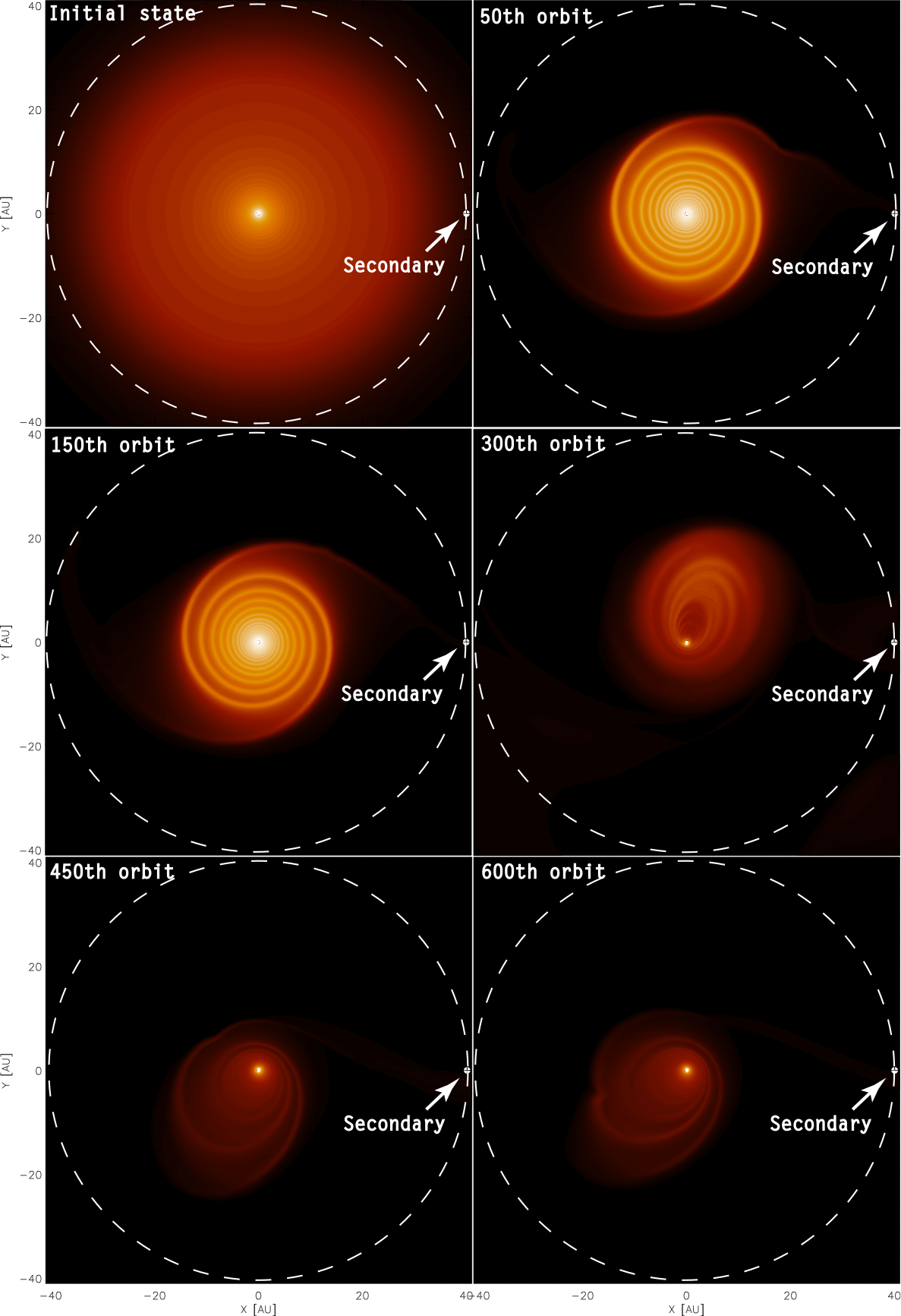 Evolution of disc eccentricity in a small separation binary system. 
Evolution of disc eccentricity. |
|
We find that the orbital velocity distribution of the gas parcels differs significantly from the circular Keplerian fashion. The line profiles are double-peaked and asymmetric in shape. The magnitude of asymmetry is insensitive to the binary mass ratio, the magnitude of viscosity (α), and the disc mass. In contrast, the disc eccentricity, thus the magnitude of the line profile asymmetry, is influenced significantly by the binary eccentricity and the disc geometrical thickness. |
|

CO P10 line profile distortions during a precession period of the eccentric disc. | |
|
We demonstrate that the disc eccentricity profile in the planet-forming region can be determined by fitting the high-resolution CO line profile asymmetry using a simple 2D spectral model that accounts for the velocity distortions caused by the disc eccentricity. Thus, with our novel approach the disc eccentricity can be inferred from high-resolution near-IR spectroscopy data acquired prior to the era of high angular resolution optical (ELT) or radio (ALMA, E-VLA) direct-imaging. By determining the disc eccentricity in medium-separation young binaries, we might be able to constrain the planet formation theories. |
|
Appeared in Regály, Zs.; Sándor, Zs.; Dullemond, C. P.; Kiss, L. L., 2011, A&A, Volume 528, id.A93
ADS:2011A&A...528A..93R,
arXiv:1101.1820
Asymmetric ro-vibrational CO lines as a sign of an embedded giant-planet
|
Protoplanetary disks are expected to emit symmetric double-peaked molecular lines in infrared wavelengths as a result of the Keplerian angular velocity distribution of gas parcels (Horne & Marsh 1986). Contrary to this, asymmetric line profiles have been observed in the fundamental band of CO for several young (1–5 Myr) protoplanetary disks (Pontoppidan et al. 2008; Blake & Boogert 2004; Dent et al. 2005; Salyk et al. 2009; Brown et al. 2013). The theory of resonant excitation mechanisms in accre- tion disks of Lubow (1991) predicts that the circumstellar disks of close-separation young binaries become fully eccentric due to the orbiting companion. As it was shown by Regály et al. (2011) a disk having a non-constant radial eccentricity profile with ∼ 0.2–0.3 average eccentricity emits clearly asymmetric fundamental band CO lines. Since no close stellar mass companions were found for the majority of disks that emits asymmetric lines, it is worth investigating whether a giant planet is able to excite global disk eccentricity inside its orbit where the CO is thermally excited. |
||
|
The interaction between the disk and the embedded giant planet with 2.5, 5 and 10 Jupiter mass for a 0.5, 1 and 2 Stellar mass central star, respectively, orbiting at fixed distance ap = 1, 3, 5, 7, and 10 AU has been investigated by two-dimensional grid-based, global hydrodynamic simulations. We used the GPU supported version of the code FARGO (Masset 2000), which solves the vertically integrated continuity and Navier–Stokes equations numerically, using locally isothermal approximation. Thanks to the high computational performance provided by the GPUs, we were able to follow the viscous evolution to t ≃ 40 × 10^3 yr. The giant planet opens a gap in a couple of orbits, then significant disk eccentricity develops at the gap outer edge in ∼ 500 orbits. Integrating further, we found that the disk also becomes eccentric inside the planetary orbit (see movie on the right). |
Global excitation of the disk eccentricity in ∼ 500 orbits. |
|
|
In order to calculate the CO lines, we used a previously developed semianalytical thermal excitation model (Regály et al. 2010). Our thermodynamical model is based on the double-layer disk model of Chiang & Goldreich (1997). The disk is approximated by an optically thin hot atmosphere heated by the absorption of stellar irradiation by the dust and an optically thick interior heated by the atmosphere and accretion processes. The total emission is the sum of the stellar emission, atmospheric gas lines, dust continuum from the disk atmosphere, and interior. The fundamental band (V = 1 → 0) of CO lines are calculated considering an intrinsic line profile shaped by the thermal broadening and the Doppler shifts based on the perturbed orbital velocity of the gas provided by the hydrodynamical simulations (see Fig. on the right). |
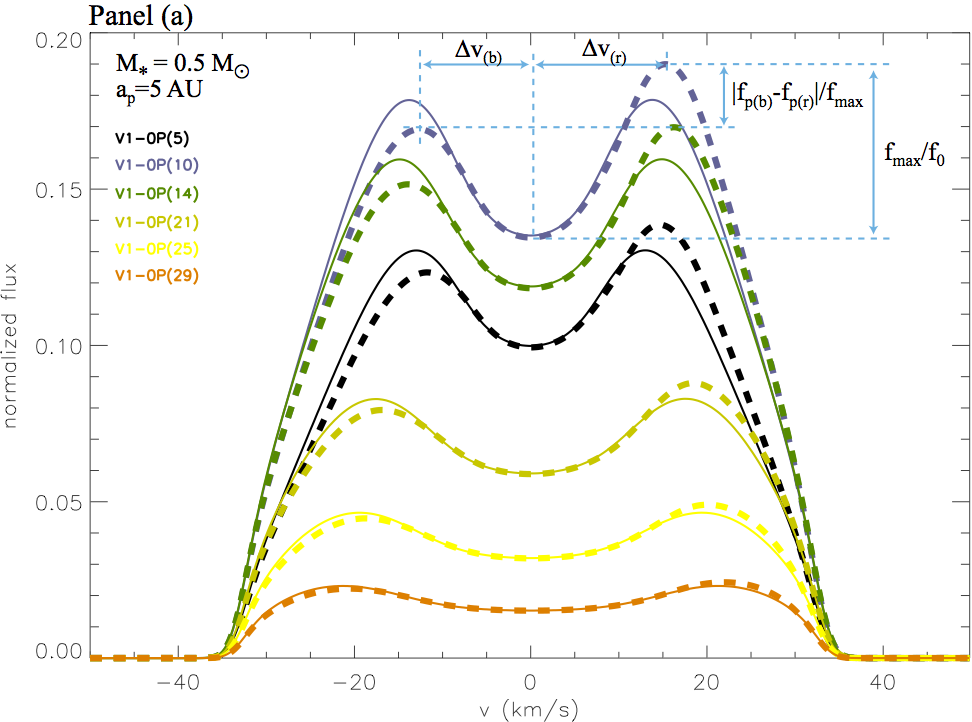 Asymmetric (V = 1 → 0) CO-lines. 
Asymmetric (V = 1 → 0) CO-lines. |
|
|
The principal results of our study are:1. A quasi-static, globally eccentric disk state develops inside the planetary orbit with ⟨e⟩ = 0.2–0.25 after several thousand orbits by t ≃ 40 × 10^3 yr.2. As a result, asymmetric lines are formed with magnitude of ∼ 10%–20% measured in red versus blue peak, whose strength increases with decreasing orbital distance of the planet.3. The lines are off-centered, i.e., shifted toward the higher flux peak by ∼ 4–10 kms−1, such that the smaller the orbital distance of the planet or the larger the stellar mass, the greater the shift.4. The line asymmetry–J slope informs us whether the giant planet orbits outside (asymmetry de- creases with J ) or inside (asymmetry increases with J) the thermally excited CO region. The critical orbital distance is ap ≃ 3, 5, and 7 AU for an M = 0.5, 1, and 2 Solar mass star, where the asymmetry–J slope changes its sign.5. For close planetary orbits (ap ≤ 1, 3, and 5 AU for an M = 0.5, 1, and 2 Solar mass star), the lines are highly distorted.), the CO lines do not show clear asymmetry; rather, highly perturbed lines are formed (as was shown previously in Regály et al. 2010) because the planet-induced gap is formed inside the CO excitation region.6. The peak distances, peak positions, and magnitude of the central dip are found to be proportional to J independent of the planetary and stellar masses. |
||
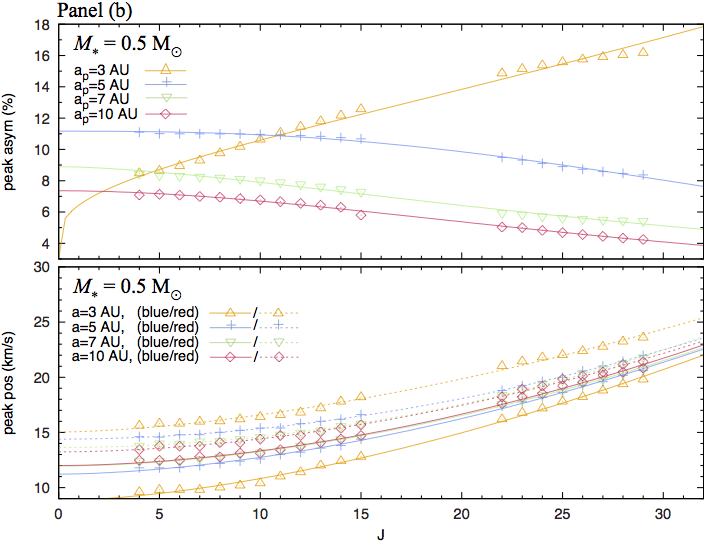
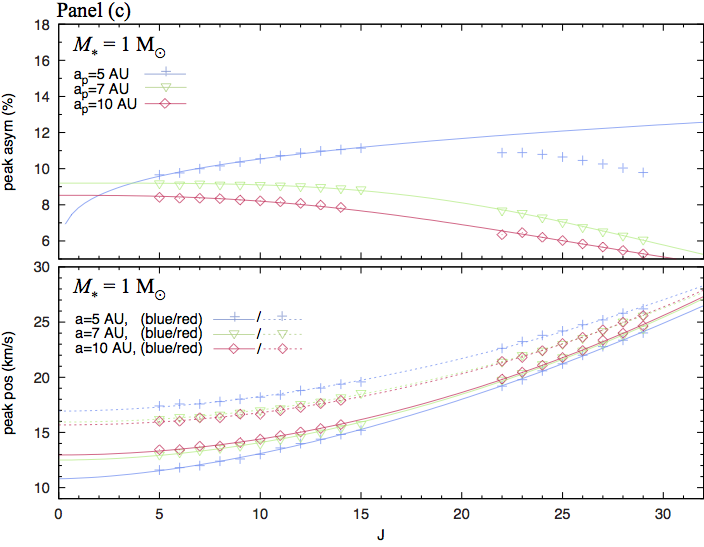
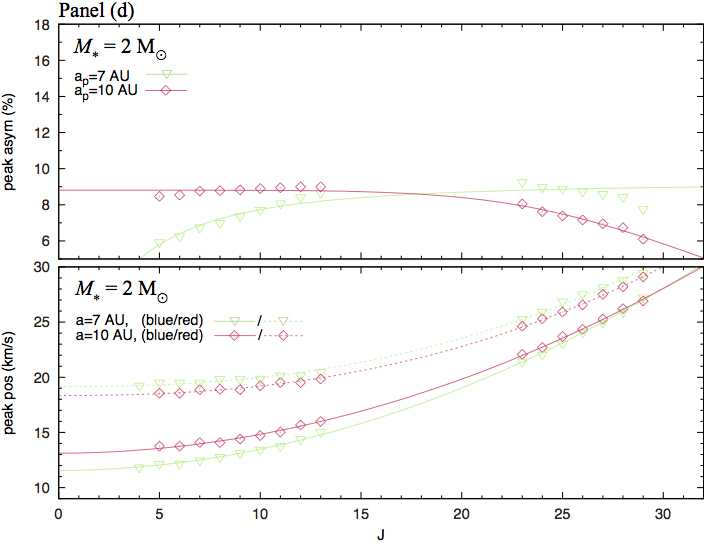
Line asymmetry (upper sub-panels) and red/blue peak positions (lower sub-panels) for a 0.5, 1, and 2 Solar mass central star. |
||
Appeared in Regály, Zs.; Király, S.; Kiss, L. L., 2014, ApJ, Volume 785, L31
ADS:2014ApJ...785L..31R,
arXiv:1403.2539

